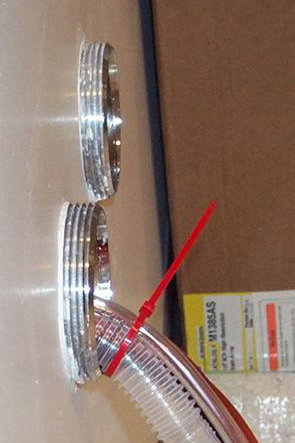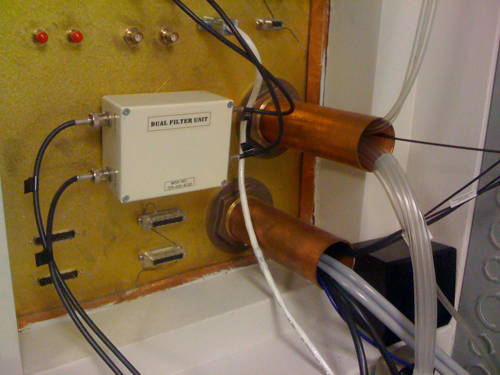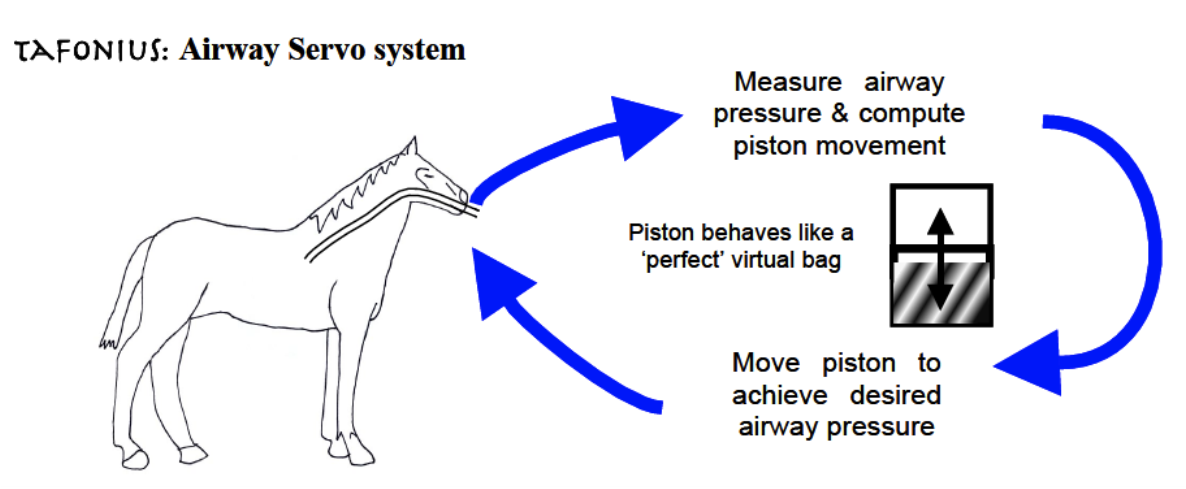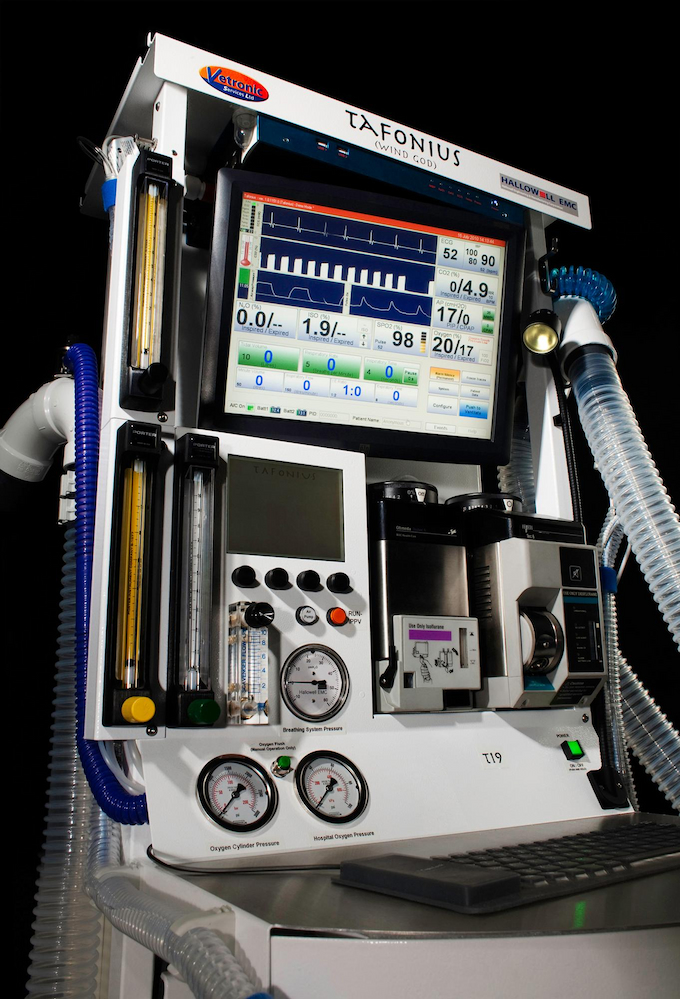

Standard Features:
Accessories Supplied:
Optional Items Available:

If the Servo Airway pressure is set to 0 cm H2O then the patient experiences no resistance to breathing out, significantly reducing the work of breathing. To the patient it feels like exhaling to ambient with no machine attached. If the Servo Airway pressure is set to 5cm H2O then the patient experiences 5cm of CPAP or PEEP. With the combination of multiple phases and an Airway Servo System, any pattern of breathing can be designed and implemented. In time, researchers will develop a library of ventilating modes, patterns, sequences and maneuvers that can be used to ventilate your patient. You will no longer need to buy another machine to obtain new features.
"Tafonius - undeniably the last word in mechanical lung ventilators"
The University of Edinburgh Royal (Dick) School of Veterinary Studies

Standard Tafonius 000A4630 comes with:
Tafonius Options:
Electronic control-- Eliminates the substantial driving gas required to operate pneumatically controlled ventilators.
Time cycled-- Ensures consistently spaced breaths. The possibility of stacking breaths or auto-PEEP is eliminated by keeping the I:E ratio constant at 1:2. This means that regardless of the respiratory rate setting two-thirds of the breath will remain for expiration. The respiratory rate is adjustable from 6 - 40 breaths per minute (BPM).
Volume constant-- Ensures that each delivered breath will have essentially the same volume, independent of changes in animal patient compliance and airway resistance. The deliverable tidal volume (TV) range is from approximately 20 cc to 3,000 cc.
Pressure Limited-- Provides for animal patient safety by limiting the maximum working pressure (MWPL) to a user adjustable pressure range of 10 - 60 cm H2O.
Ventilators are equipped with dual airway pressure alarms that monitor and sound when the peak inspiratory pressure (PIP) of any breath either exceeds the preset maximum working pressure limit (MWPL); or fails to reach 6 cm H2O as in the case of a disconnect.
Adjustable I:E Ratio
Available on all models of the 2002 and 2000 is the option of having an adjustable I:E Ratio control. Normally, without this option, the I:E Ratio is fixed at 1:2, that is, 1/3 of the period of each breath is inspiration and 2/3 of each breath is exhalation. Regardless of the respiratory rate, the animal patient will always have 2/3 of the cycle to exhale. This I:E ratio can also be adjusted to a fixed value other than 1:2 at no extra charge.
The adjustable range is from 1:1.5 to 1:4. The pros and cons are that this option affords the operator more flexibility in dealing with animals that have compromised lung function. But during anesthesia most animal patients are lung healthy and the addition of this control can add to the complexity of setting the ventilator. For example consider that you have a hypocapnic animal patient. To bring that animal patients' CO2 level to a more normal range you must decrease the overall gas exchange, the Minute Volume (MV). Without this option, only one knob controls the MV, that is the Volume control. With this option; however, increasing the I:E ratio would also cause a reduction in MV.
Electronic control-- Eliminates the substantial driving gas required to operate pneumatically controlled ventilators.
Time cycled-- Ensures consistently spaced breaths. The possibility of stacking breaths or auto-PEEP is eliminated by keeping the I:E ratio constant at 1:2. This means that regardless of the respiratory rate setting two-thirds of the breath will remain for expiration. The respiratory rate is adjustable from 6 - 40 breaths per minute (BPM).
Volume constant-- Ensures that each delivered breath will have essentially the same volume, independent of changes in animal patient compliance and airway resistance. The deliverable tidal volume (TV) range is from approximately 20 cc to 3,000 cc.
Pressure Limited-- Provides for animal patient safety by limiting the maximum working pressure (MWPL) to a user adjustable pressure range of 10 - 60 cm H2O.
Ventilators are equipped with dual airway pressure alarms that monitor and sound when the peak inspiratory pressure (PIP) of any breath either exceeds the preset maximum working pressure limit (MWPL); or fails to reach 6 cm H2O as in the case of a disconnect.
Adjustable I:E Ratio
Available on all models of the 2002 and 2000 is the option of having an adjustable I:E Ratio control. Normally, without this option, the I:E Ratio is fixed at 1:2, that is, 1/3 of the period of each breath is inspiration and 2/3 of each breath is exhalation. Regardless of the respiratory rate, the animal patient will always have 2/3 of the cycle to exhale. This I:E ratio can also be adjusted to a fixed value other than 1:2 at no extra charge.
The adjustable range is from 1:1.5 to 1:4. The pros and cons are that this option affords the operator more flexibility in dealing with animals that have compromised lung function. But during anesthesia most animal patients are lung healthy and the addition of this control can add to the complexity of setting the ventilator. For example consider that you have a hypocapnic animal patient. To bring that animal patients' CO2 level to a more normal range you must decrease the overall gas exchange, the Minute Volume (MV). Without this option, only one knob controls the MV, that is the Volume control. With this option; however, increasing the I:E ratio would also cause a reduction in MV.
Also available the Model 2002PRO
Electronic control-- Eliminates the substantial driving gas required to operate pneumatically controlled ventilators.
Time cycled-- Ensures consistently spaced breaths. The possibility of stacking breaths or auto-PEEP is eliminated by keeping the I:E ratio constant at 1:2. This means that regardless of the respiratory rate setting two-thirds of the breath will remain for expiration. The respiratory rate is adjustable from 6 - 40 breaths per minute (BPM).
Volume constant-- Ensures that each delivered breath will have essentially the same volume, independent of changes in animal patient compliance and airway resistance. The deliverable tidal volume (TV) range is from approximately 20 cc to 3,000 cc.
Pressure Limited-- Provides for animal patient safety by limiting the maximum working pressure (MWPL) to a user adjustable pressure range of 10 - 60 cm H2O.
Ventilators are equipped with dual airway pressure alarms that monitor and sound when the peak inspiratory pressure (PIP) of any breath either exceeds the preset maximum working pressure limit (MWPL); or fails to reach 6 cm H2O as in the case of a disconnect.
Adjustable I:E Ratio
Available on all models of the 2002 and 2000 is the option of having an adjustable I:E Ratio control. Normally, without this option, the I:E Ratio is fixed at 1:2, that is, 1/3 of the period of each breath is inspiration and 2/3 of each breath is exhalation. Regardless of the respiratory rate, the animal patient will always have 2/3 of the cycle to exhale. This I:E ratio can also be adjusted to a fixed value other than 1:2 at no extra charge.
The adjustable range is from 1:1.5 to 1:4. The pros and cons are that this option affords the operator more flexibility in dealing with animals that have compromised lung function. But during anesthesia most animal patients are lung healthy and the addition of this control can add to the complexity of setting the ventilator. For example consider that you have a hypocapnic animal patient. To bring that animal patients' CO2 level to a more normal range you must decrease the overall gas exchange, the Minute Volume (MV). Without this option, only one knob controls the MV, that is the Volume control. With this option; however, increasing the I:E ratio would also cause a reduction in MV.
Also available the Model 2002PRO
Time cycled-- Ensures consistently spaced breaths. The possibility of stacking breaths or auto-PEEP is eliminated by keeping the I:E ratio constant at 1:2. This means that regardless of the respiratory rate setting two-thirds of the breath will remain for expiration. The respiratory rate is adjustable from 6 - 40 breaths per minute (BPM).
Volume constant-- Ensures that each delivered breath will have essentially the same volume, independent of changes in animal patient compliance and airway resistance. The deliverable tidal volume (TV) range is from approximately 20 cc to 3,000 cc.
Pressure Limited-- Provides for animal patient safety by limiting the maximum working pressure (MWPL) to a user adjustable pressure range of 10 - 60 cm H2O.
Ventilators are equipped with dual airway pressure alarms that monitor and sound when the peak inspiratory pressure (PIP) of any breath either exceeds the preset maximum working pressure limit (MWPL); or fails to reach 6 cm H2O as in the case of a disconnect.
Adjustable I:E Ratio
Available on all models of the 2002 and 2000 is the option of having an adjustable I:E Ratio control. Normally, without this option, the I:E Ratio is fixed at 1:2, that is, 1/3 of the period of each breath is inspiration and 2/3 of each breath is exhalation. Regardless of the respiratory rate, the animal patient will always have 2/3 of the cycle to exhale. This I:E ratio can also be adjusted to a fixed value other than 1:2 at no extra charge.
The adjustable range is from 1:1.5 to 1:4. The pros and cons are that this option affords the operator more flexibility in dealing with animals that have compromised lung function. But during anesthesia most animal patients are lung healthy and the addition of this control can add to the complexity of setting the ventilator. For example consider that you have a hypocapnic animal patient. To bring that animal patients' CO2 level to a more normal range you must decrease the overall gas exchange, the Minute Volume (MV). Without this option, only one knob controls the MV, that is the Volume control. With this option; however, increasing the I:E ratio would also cause a reduction in MV.
Also available the Model 2002PRO
Looks like you haven't made a choice yet.